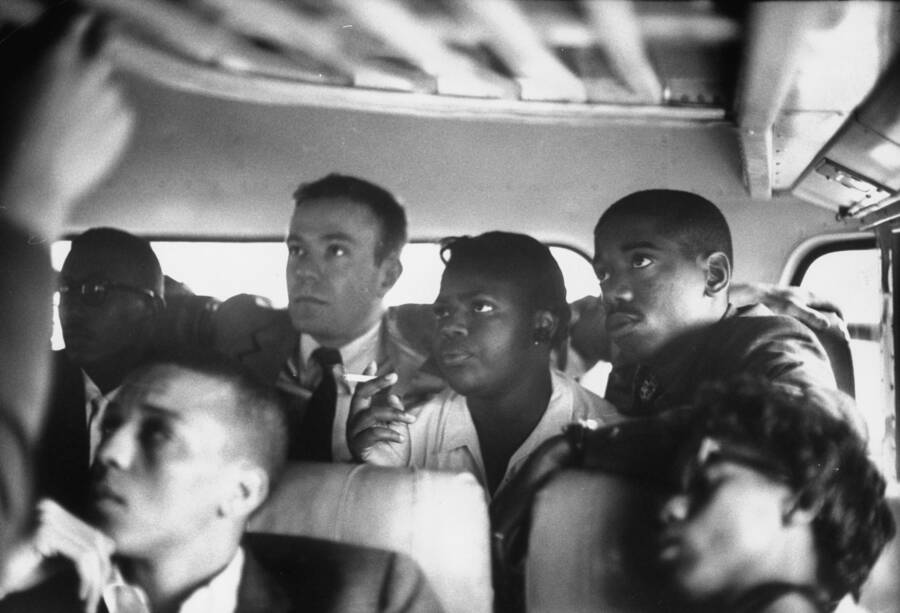
.jpg)
A diverse group of volunteers came from 39 states, and were from different economic classes and racial backgrounds. Many of the Riders were sponsored by CORE and SNCC with 75% of the Riders between 18 and 30 years old. Their plan was to ride through Virginia, the Carolinas, Georgia, Alabama, and Mississippi, ending in New Orleans, Louisiana, where a civil rights rally was planned. Harbour (19), Joan Trumpauer Mullholland (19), and Ed Blankenheim), left Washington, DC, on Greyhound (from the Greyhound Terminal) and Trailways buses. Led by CORE Director James Farmer, 13 young riders (seven black, six white, including but not limited to John Lewis (21), Genevieve Hughes (28), Mae Frances Moultrie, Joseph Perkins, Charles Person (18), Ivor Moore, William E.

The first Freedom Ride began on May 4, 1961. Rustin, Igal Roodenko, Joe Felmet and Andrew Johnnson, were arrested and sentenced to serve on a chain gang in North Carolina for violating local Jim Crow laws regarding segregated seating on public transportation. Like the Freedom Rides of 1961, the Journey of Reconciliation was intended to test an earlier Supreme Court ruling that banned racial discrimination in interstate travel. The Freedom Riders were inspired by the 1947 Journey of Reconciliation, led by Bayard Rustin and George Houser and co-sponsored by the Fellowship of Reconciliation and the then-fledgling Congress of Racial Equality (CORE). In some localities, such as Birmingham, Alabama, the police cooperated with Ku Klux Klan chapters and other white people opposing the actions, and allowed mobs to attack the riders. Southern local and state police considered the actions of the Freedom Riders to be criminal and arrested them in some locations. The Supreme Court's decision in Boynton supported the right of interstate travelers to disregard local segregation ordinances. The Freedom Rides, beginning in 1960, followed dramatic sit-ins against segregated lunch counters conducted by students and youth throughout the South, and boycotts of retail establishments that maintained segregated facilities. The Congress of Racial Equality (CORE) sponsored most of the subsequent Freedom Rides, but some were also organized by the Student Nonviolent Coordinating Committee (SNCC). Police arrested riders for trespassing, unlawful assembly, violating state and local Jim Crow laws, and other alleged offenses, but often they first let white mobs attack them without intervention. They called national attention to the disregard for the federal law and the local violence used to enforce segregation in the southern United States. The Freedom Rides, and the violent reactions they provoked, bolstered the credibility of the American Civil Rights Movement. The Freedom Riders challenged this status quo by riding interstate buses in the South in mixed racial groups to challenge local laws or customs that enforced segregation in seating. The ICC failed to enforce its ruling, and Jim Crow travel laws remained in force throughout the South. Ferguson (1896) doctrine of separate but equal in interstate bus travel. Carolina Coach Company (1955) that had explicitly denounced the Plessy v. Five years prior to the Boynton ruling, the Interstate Commerce Commission (ICC) had issued a ruling in Sarah Keys v. īoynton outlawed racial segregation in the restaurants and waiting rooms in terminals serving buses that crossed state lines. The first Freedom Ride left Washington, D.C., on May 4, 1961, and was scheduled to arrive in New Orleans on May 17. The Southern states had ignored the rulings and the federal government did nothing to enforce them. Virginia (1960), which ruled that segregated public buses were unconstitutional.

Freedom Riders were civil rights activists who rode interstate buses into the segregated Southern United States in 1961 and subsequent years to challenge the non-enforcement of the United States Supreme Court decisions Morgan v.


 0 kommentar(er)
0 kommentar(er)
